#Alfred Stevens
Explore tagged Tumblr posts
Text
Archaic Words: Colours

for your next poem/story
Adarnech - colour like gold
Albyn - white
Argentine - silver
Ashied - made white
Aureat - golden
Bicollede - blackened
Blackbrown - brunette
Blewing - blue paint
Bleye - blue
Brune - brown
Camet - silver
Ende - a blue colour
Falwe - yellow
Florrey - a blue dye
Gaudy green - a light green colour
Ginger - a pale red colour
Gold-hewen - of a golden colour
Gridelin - a sort of colour composed of white and red
Grisard - grey
Grizle - a darkish grey
Inde - azure-coloured
Minim - a kind of brown tawny colour
Parvenke - a pink
Pear-coloured - red
Purpuring - having a purple colour
Sangronie - blood-red colour
Shay - a light colour
True blue - the best blue colour
Tuly - a kind of red or scarlet colour
Umber - a sort of brown colour
Vermaile - red
Virent - green, unfaded
Watchet - a pale blue colour
Whity brown - a pale dusky brown
Yvor - ivory
Source ⚜ More: Notes ⚜ Word Lists ⚜ Writing Resources PDFs
#archaic#word list#langblr#language#linguistics#writeblr#dark academia#writing reference#spilled ink#creative writing#light academia#literature#writing inspiration#writing ideas#writers on tumblr#poets on tumblr#writing prompt#poetry#colour#alfred stevens#writing resources
3K notes
·
View notes
Text

Winter, 1877
Alfred Stevens
475 notes
·
View notes
Text

Young Woman Reading (1856) by Alfred Émile Léopold Stevens (1823-1906), oil on canvas, Private Collection
#young woman reading#alfred stevens#alfred emile leopold stevens#painting#oil on canvas#private collection#art#fine art#my upload
710 notes
·
View notes
Text
going through alfred stevens' paintings and came across one piece of a lady with a tiny dog on her arm
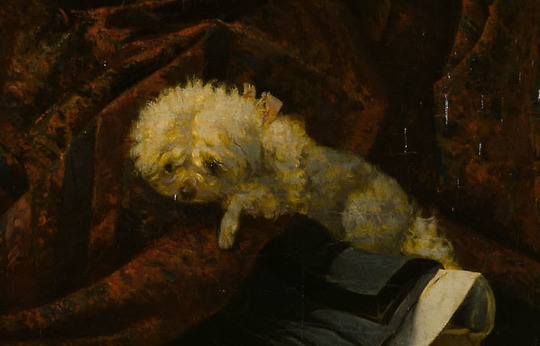
924 notes
·
View notes
Text
Alfred Stevens, Después del baile
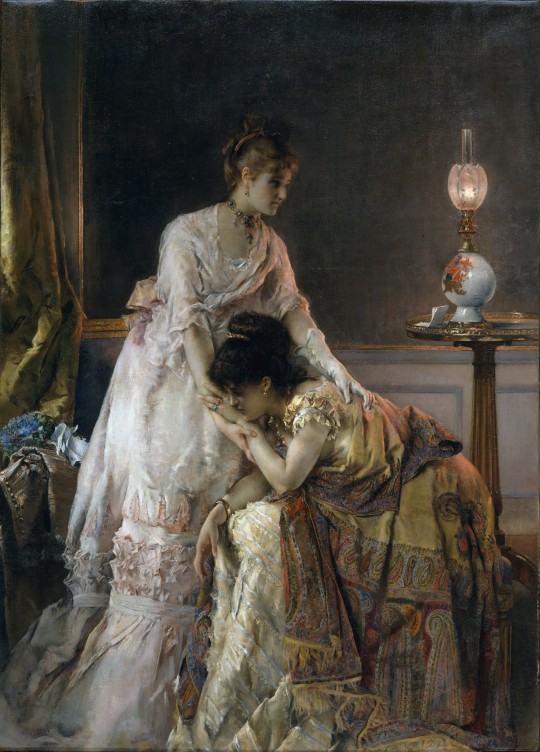
#traditional art#traditional painting#classic art#classical art#art history#art detail#art details#19th century art#oil painting#art#artwork#contemporary art#1800s art#fine art#alfred stevens#oil paintings#oil on canvas
967 notes
·
View notes
Photo
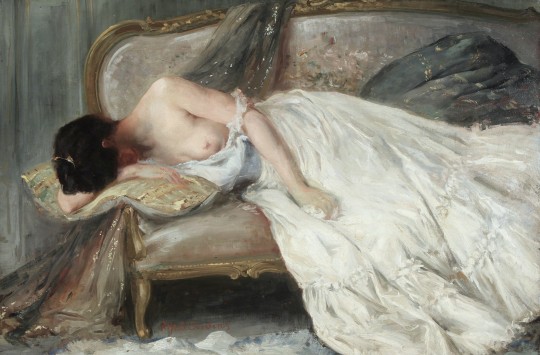
Alfred Stevens (1823-1906, Belgian) ~ Reclining Partial Nude, n/d
5K notes
·
View notes
Text




The Four Seasons | 1877 Alfred Stevens
#alfred stevens#romanticism#women in art#portrait#four seasons#19th century fashion#fashion in art#romantic art#1870s#art#gilded age#victorian era#💮💮
98 notes
·
View notes
Text









art history moodboard – mina harker
for @brambleberrycottage ❤️
visit the art museum
The Sick Girl – Félix Vallotton // Vampire – Edvard Munch // The Letter – Alfred Stevens // Trompe l’œil: A Quodlibet with Letters and a Roll of Blue Paper – Cornelis Norbertus Gijsbrechts // Portrait of a Russian Actress – Konrad Krzyżanowski // Allegory of the Eucharist – unknown artist // Study in Red (Emily Gertrude Littlejohns Bartlett) – Charles William Bartlett // Young Woman Writing a Letter – Federico Zandomeneghi // Illustration from La Morte Amoureuse – Eugène Decisy and Paul Albert Laurens
#charlotte's art museum milestone celebration#charlotte makes moodboards#art history moodboard#moodboards#character moodboard#felix vallotton#edvard munch#alfred stevens#federico zandomeneghi#mina harker#mina murray#mina harker aesthetic#mina harker moodboard#mina murray aesthetic#mina murray moodboard#dracula#dracula 1897#vampire#vampires#art#art history
255 notes
·
View notes
Text
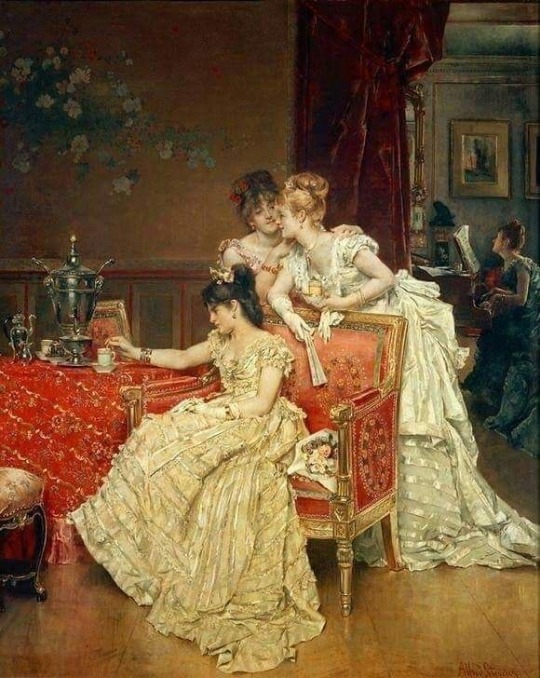
The Cup of Tea, Alfred Stevens. 1874.
#aesthetic#art#art history#fashion#historical fashion#victorian#historical art#women in art#victorian aesthetic#women#Victorian fashion#1870s#1870s aesthetic#1870s hairstyles#Alfred Stevens#historical#history#Belgian art#Victorian era#Victorian women#gilded age#the gilded age#gilded age fashion
454 notes
·
View notes
Text

The Porcelain Collector
Artist: Alfred Stevens (Belgian, 1823-1906)
Date: 1868
Medium: Oil on canvas
Collection: North Carolina Museum of Art, Raleigh, NC, United States
#painting#oil on canvas#genre art#woman#full length#standing#porcelain collector#oil painting#table#art#costume#porcelain vase#bookcase#books#interior#textiles#alfred stevens#belgian painter#belgian art#19th century painting#european art
98 notes
·
View notes
Text

"Moonlight seascape"(1892) by Alfred Stevens (1823-1906,Belgian)
181 notes
·
View notes
Text
How to Describe Clothing in Writing
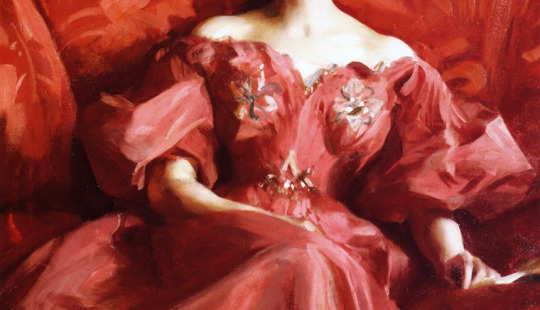
Creating vivid descriptions for a story or character is a mark of a great writer. One specific form of descriptive writing that particularly affects setting and characterization is the portrayal of characters’ clothing.
Writing Tips: Describing Clothes
Clothing descriptions work best when they appear organically in the course of the narrative. The story should never halt in place so that you can shoehorn in a bunch of sartorial descriptions. Here are some writing tips to help you use clothing descriptions in your creative writing:
Integrate clothing into your initial character description. The first time readers meet a character, they should get a sense of how they dress.
Study articles of clothing to make sure you know what they look like. This will help you choose the right words to describe them. For example, it would be appropriate to describe a chiffon dress as “sheer” or “thin,” but it would be clumsy to describe it as “threadbare” because chiffon is not cheap.
Pick outfits that fit the setting you’re writing about. If you’re describing an elegant ball, you might want to place a character in a form-fitting strapless evening gown, as this is a common piece for formal dances. Describing the clothing reinforces the setting you’ve chosen.
Blend clothing into job descriptions. If you’re describing a monk at work, you could note how the loose-fitting sleeves of his frock draped onto a table. If you’re describing a superhero in an action scene, describe the flow of their cape or the stiffness of their boots.
Let your characters change outfits. Show a character arc by marking how a character’s clothing changes over the course of your story. If a character in a YA novel starts out wearing ill-fitting khaki slacks with enormous pleats and ends that same novel wearing a denim jacket with an “anarchy” pin on the lapel, we know they’ve undergone some major changes.
Use clothing to set characters apart. Represent the difference between two characters by describing the differences in their clothing. Let’s say you’re describing two characters interviewing for the same job: One wears a sporty, ruched, A-line dress, and the other wears jeans and a sweatshirt. The reader can infer aspects of both characters’ personalities and make a comparison between two characters.
Reasons to Describe a Character’s Clothing
A character’s clothing is a window into so many aspects of their lives. From a character’s clothes, readers can make inferences about the following:
Clothing reveals a character’s personality. A knee-length fur coat and a corduroy jacket are both forms of outerwear, but it’s quite unlikely they’d be worn by the same kind of person. Readers can deduce a character’s style and personality from the clothes they wear.
Clothing implies a character’s wealth. Is your novel’s main character comes from a working-class background, it’s more likely they’d wear a t-shirt and jeans than a lavish and expensive piece of clothing. Just as in real life, clothing indicates status and wealth.
Clothing shows a character’s point of view toward the world. Clothing can reveal a character’s views on the world. If someone puts on a graphic t-shirt with the sleeves cut off, it implies that they could hardly care less about offending other people. Meanwhile, a character who wears a dressy button-down shirt with a single-breasted plaid jacket seems like the old-fashioned type. Maybe they’re heading to a mixer at the country club?
Clothing suggests the time and place in which a character exists. As part of your worldbuilding process, you’ll want to be as precise as possible about your book’s setting and time period. This doesn’t just apply to historical fiction; it applies to all forms of writing. For instance, if you’re writing a battle scene set during the Revolutionary War, you might need to study the physical descriptions of britches and pantaloons. But if your scene is set in a present-day battlefield, you might describe a soldier as wearing camouflage with a tag hung from a necklace. Simply by changing the clothing description, you’ve marked a massive distinction between these two war stories.
Source ⚜ More: Notes ⚜ Writing Resources PDFs ⚜ References: Fashion
#description#clothes#writing notes#fashion#writeblr#literature#writers on tumblr#dark academia#writing reference#spilled ink#writing prompt#creative writing#writing tips#writing advice#on writing#writing inspiration#writing ideas#alfred stevens#writing resources
862 notes
·
View notes
Text

Title: Moonlit seascape
Artist: Alfred Stevens
Date: 1892
Style: Impressionism
Genre: Marina
#art history#art#painting#artwork#museums#history#culture#vintage#impressionism#alfred stevens#curators
897 notes
·
View notes
Text
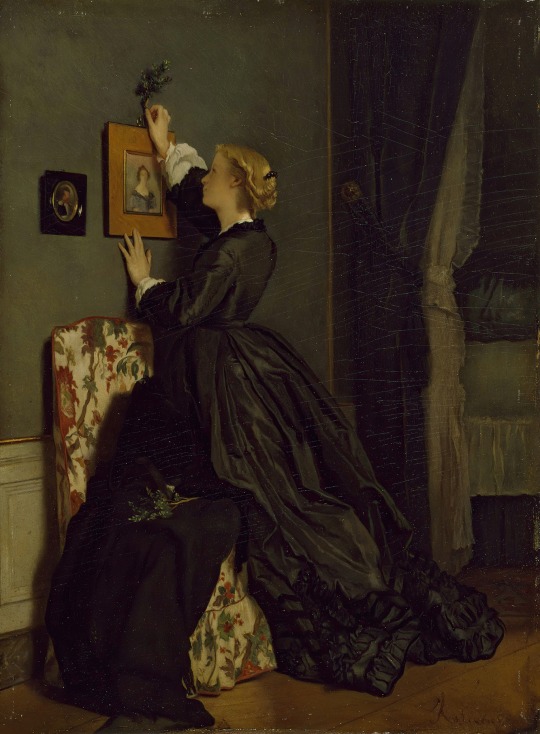
Palm Sunday, ca. 1862
Alfred Stevens
2K notes
·
View notes
Text

Alfred Stevens
45 notes
·
View notes
Text

~ Alfred Stevens, The Parisian Sphynx (1870) (detail)
This painting depicts French artist and model Victorine-Louise Meurent. She is mostly known as the model for many of Edouard Manet's paintings, including Olympia and Le Déjeuner sur l'herbe; however, she was a successful artist in her own right, and was accepted to the Salon of 1876 when Manet was not.
via wikimedia commons
#alfred stevens#victorine meurent#victorine-louise meurent#women in history#belgian painter#belgian artist#belgian art#portrait painting#portraiture#la belle epoque#belle epoque#fine art#painting#old painting#art history#european art#19th century art#art detail#painting detail#victoriana#victorian#victorian era#second empire#victorian painting#victorian art#19th century painting#1870s#1870s art#1870#e
42 notes
·
View notes